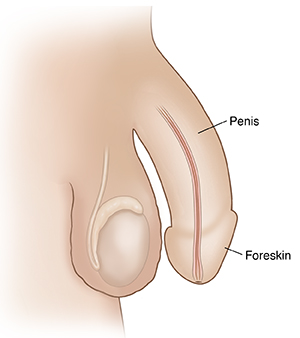Balanitis is an inflammation of the head of the penis. It can happen from a buildup of germs (bacteria, viruses, or fungi) under the foreskin. It can also happen from exposure to soaps and other chemicals. Posthitis is an inflammation of the foreskin. When these conditions occur together, it's called balanoposthitis. In adults, this most often occurs as a complication of diabetes. It can also happen because of obesity or poor genital cleaning habits.
If not treated right away, this can lead to a condition called phimosis. This is an inability to pull back the foreskin from the head of the penis.
This condition may cause pain or discharge from the penis. You may not be able to fully retract the foreskin. The inflammation can make it hard to pass urine. It can also cause impotence.
Home care
These guidelines will help you care for your condition at home:
-
If you're able to retract the foreskin:
-
Children. Gently retract the foreskin (don't force it), and clean with water 2 or 3 times a day. Depending on what has caused the infection, apply antifungal or antibiotic cream or ointment to the penis 3 times a day. Follow your doctor's advice on which medicine to use.
-
Adults. Retract the foreskin and clean with water. Apply the antifungal cream called clotrimazole to the foreskin and head of the penis 2 times a day, unless another medicine was prescribed. Clotrimazole cream is available over the counter.
-
-
Oral antibiotics may be given in severe cases or if you have a sexually transmitted infection, such as chlamydia or gonorrhea. Oral medicines may also be used when phimosis prevents treatment with creams or ointments.
-
If you have diabetes, work with your doctor to keep your diabetes in good control.
-
If you're overweight, talk with your doctor about a weight-loss plan.
-
Avoid frequent and forceful washing with soap.
-
Watch for things you might be allergic to, such as latex condoms, lubricants, and detergents used to wash underwear. Avoid anything that causes an allergic reaction.
Follow-up care
Follow up with your doctor, or as advised.
When to get medical care
Contact your doctor right away if:
-
You can't return the retracted foreskin to the forward position. This requires medical care right away.
-
Your symptoms get worse.
-
You can't pee.


